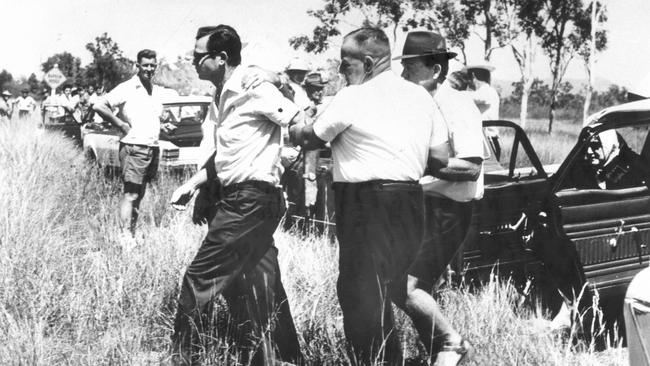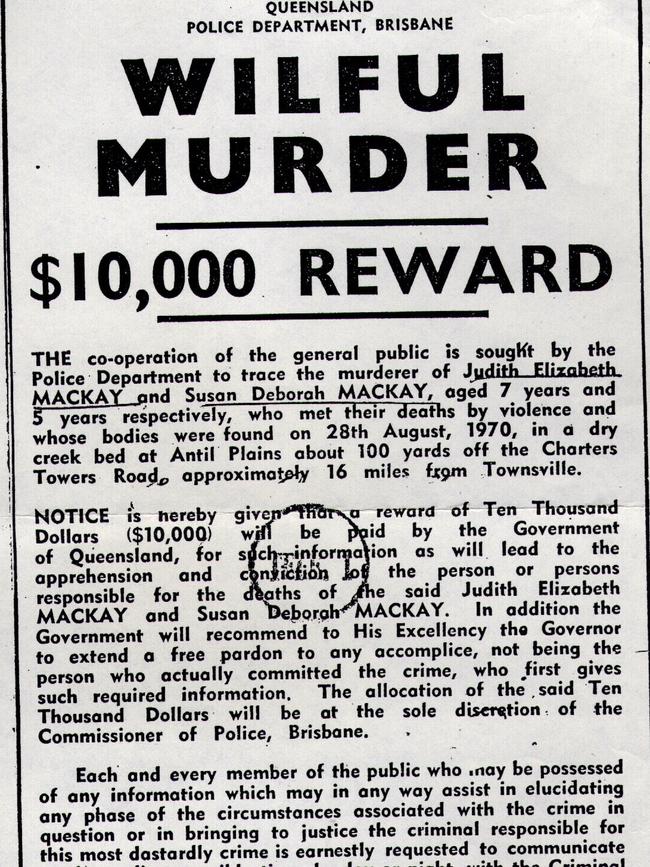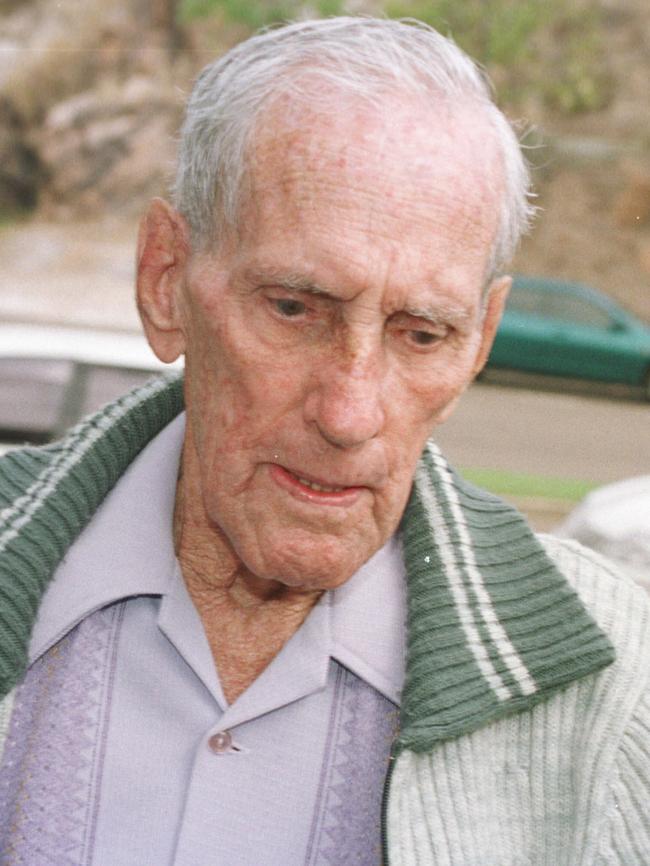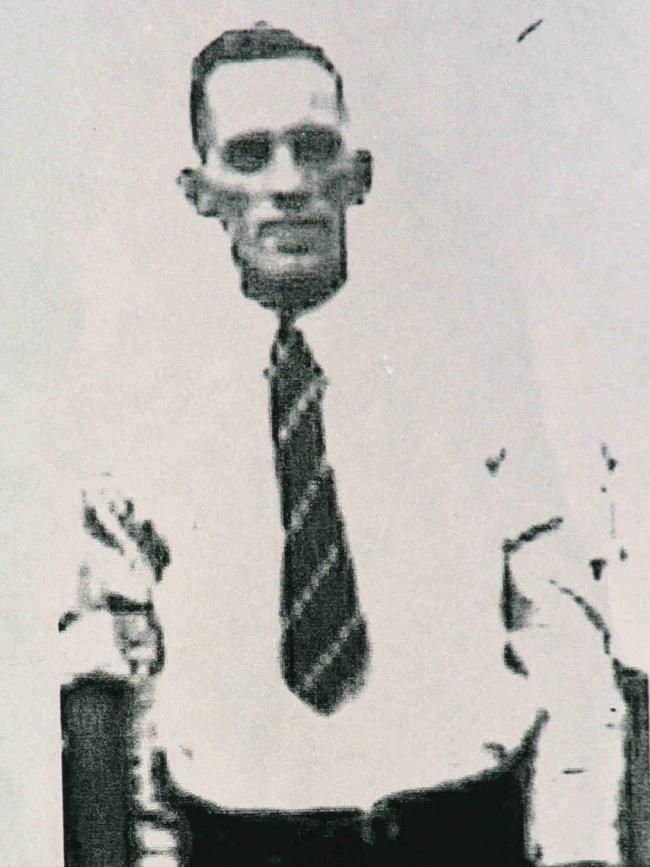Almost 50 years ago Townsville was the scene of one of the most heinous crimes in Australian history when two innocent girls were taken from a bus stop, raped and murdered in an act of unfathomable cruelty.
For nearly three decades the identity of Judith and Susan Mackay’s killer remained a mystery.
The detective who ultimately charged Townsville carpenter Arthur Stanley Brown with their murder was just seven years old when the sisters were slain.
Brown would never be convicted and died an innocent man in the eyes of the law.
However, in the eyes of detective Inspector David Hickey, the deaths of seven-year-old Judith and five-year-old Susan were undoubtedly executed at Brown’s hand.
In an extensive interview with The Bulletin, the detective recounted the harrowing murders and how police ultimately closed arguably Queensland’s highest profile cold case.
THE SEARCH AND A GRIM DISCOVERY
When Bill Mackay arrived at the scene of his daughters’ murders the sight of the devastated father brought bystanders to tears.
He had been desperately searching for Judith and Susan, praying to bring them home safe and sound.
But his beloved daughters had been taken from him in the cruellest manner imaginable and he had to be restrained by police as investigators inspected the killing ground.
“Detectives would not allow him to go down to where his girls’ final resting place was because they had to protect the crime scene,” Insp Hickey said.

“Police had to try and restrain him and calm him down at the scene he was absolutely frantic that his daughters had been discovered murdered.
“I was told hardened detectives were overawed at the moment and were visibly and emotionally upset … these were two little children.”
Just two days prior, on August 26, 1970 the Mackay family started their day as they would normally.
It was common practice was for the two youngest children, Judith (7) and Susan (5) to catch the bus to Aitkenvale State School.
The Mackay’s Albert St home was only a short walk from the bus stop on Ross River Rd and the girl’s mother, Thelma, would watch them walk to the corner with their bags packed and uniforms freshly pressed.
Insp Hickey said the girls’ older brother Alan would often ride his bike past them, waiting at the bus stop, as he made his own way to school.
About 8.25am he passed the bus stop but his sisters were nowhere in sight… he assumed the bus had arrived early.
Bill and Thelma Mackay raised the alarm that afternoon when their daughters didn’t come home and the matter was treated as suspicious immediately after it was revealed the pair had never made it to school.
Police commenced searches for the children that evening.
News of the missing girls broke in The Bulletin the following day prompting thousands of civilians to join police, military personnel and the Mackay family in one of North Queensland’s most intense searches on record.
“It degree to which the community was immediately engaged was quite exceptional,” Insp Hickey said.

“This was two young babies who had been taken from a bus stop which was virtually an unheard of crime back then.
“As what appeared to be a random abduction of two very young, very vulnerable children, from a public bus stop this was deserving of a lot of community assistance.”
On August 28 the search grew even larger.
Taxi driver Ronald Brooker had been instructed to take three men to search the Anthill Creek area about 25km outside the city.
About 10.30am one of those searchers, Richard Tough, made the heartbreaking discovery.
Judith’s body was spotted first; she had been raped, strangled, and left wearing only a pair of pink underwear in a small culvert of the creek bed.
Susan’s naked body was found face down in the sand less than 50m away from her sister.
She had also been sexually assaulted and was smothered to death by her attacker.
Both sisters had also been stabbed three times in the chest by their killer.
The murderer had taken the time to neatly fold and pile each sister’s clothing which was found beside their respective bodies. Their school bags were found nearby.

THE INITIAL INVESTIGATION
Insp Hickey said the shocking and unprecedented nature of the crime motivated police into conducting the largest murder investigation Queensland had ever seen.
The desire to track down the man responsible for the murders was so great that detectives were sleeping at Townsville Police Station to maximise their time on the case.
Several officers gave up their annual leave to work the case while dozens from across the state descended on Townsville either voluntarily or under direction.
Information came rolling in at a rate of knots and police were quick to identify several key witnesses.
Judith Drysdale reported she was driving along Ross River Rd shortly before 8.25am and had seen two young girls in Aitkenvale State School uniform crossing the road near the bus stop.
Mrs Drysdale had noticed a car, which she described as light blue or grey, parked nearby with a single male occupant. She described the car as being similar to a 1963 or 1964 Holden sedan.
“She saw the car parked there and the man starring at the students and possibly saying something to the girls,” Insp Hickey said.
“At the time she felt uncomfortable about the male but elected not to stop.”
Mrs Drysdale described the man as having a long, thin face with very high cheek bones, clean shaven with dark ‘mop hair’.
A council worker, William Hankin, reported seeing two girls wearing Aitkenvale school uniforms looking out the back seat of a light coloured sedan as it drove on Nathan St about 8.30am.
Phyllis Roper reported a similar sighting on Nathan St but identified the car as a Vauxhall Victor.
Neil Lunney told police he had on several occasions attempted to overtake a light coloured sedan carrying two small girls about 8.30am but each time the driver would speed up to stop his manoeuvre.
“He saw (the car) contained a thin faced male with ‘mousy features’ and two young school girls with Aitkenvale State School uniforms,” Insp Hickey said.
One of the most haunting witness sightings came from Jean Thwaite who was working as a service station attendant at Ayr when a light blue sedan stopped for fuel.
She said two children in Aitkenvale State School uniform were in the car, the smaller of the pair in the rear seat and the other in the front.
As Ms Thwaite opened the fuel cap behind the rear passenger door she noticed the smaller child crying.
“She also noticed the slightly older girl having some form of protest with the driver,” Insp Hickey said.
“She recalled words to the effect of ‘you promised to take us to mummy’.”
There were several witness reports relating to the Anthill Creek area. A group of rail workers saw a man attempting to hide in the bushes near a light blue sedan.
One of the men noted the car had an odd coloured, dark blue, driver’s door.
About 12.50pm Robert Sim saw a sedan in the area and stated that it was definitely not a Holden.
At 1.20pm Michael and Ruby Bach also observed a sedan and also noted it had a dark blue driver’s door which did not match the rest of the car.
They saw a man nearby with a thin build and ‘moppy hair’.
Another witness, a young boy, told police the car he saw was the same as his brothers, an FJ Holden.
The investigation was headed by detective Sergeant Charles Boph who would go on to achieve the rank of superintendent.
Insp Hickey said then Police Commissioner Norwin Bauer, in late 1970, flew up from Brisbane to assume command and oversee the investigation until he was satisfied that every possible inquiry was done.
With a wealth of information from the public, detectives launched into the investigation considering the car description as their best lead.
Two manufacturers had been named by witnesses, the common Holden and much rarer Vauxhall.
Police and the media focused their attention on a light coloured Holden sedan with an odd coloured driver’s door.
Decades later Insp Hickey would conclude this is where the investigation went awry.

COLD CASE BREAKTHROUGH
Insp Hickey was the same age as Judith Mackay when the sisters were murdered in 1970.
By 1998 the investigation into the girls’ deaths was one of Queensland’s longest running cold cases; it had been revisited several times over the years but without breakthrough.
Insp Hickey had just returned to the Homicide Squad after a stint with the National Crime Authority (now known as the Australian Criminal Intelligence Commission).
Retired Assistant Commissioner Peter Barron was the detective Inspector leading the Homicide Squad who tasked Insp Hickey with conducting a complete review into the Mackay sisters’ investigation.
“He was a young constable in North Queensland in 1970 so he was very familiar with the case and it was something that had always eaten away at him,” Insp Hickey said.
“The fact that we had an offender out in the community who had abducted, raped and murdered two young primary school children.
“But it was the coldest of cases and I just thought… what am I going to do with this?”
So the detective locked himself in a room and trawled through boxes and boxes of information with his partner at the time, detective Sergeant Brendan Rook.
Acting on the suspicion that the killer had likely committed sexual offences against children before and after the murders the police launched a fresh media campaign asking for information, not just on the Mackay sisters case but any child sex offending.
This prompted Merle Moss to phone Crime Stoppers.
“She said she had information on a ‘sexual deviant’ in Townsville who had an obsession with the Mackay sisters’ murders,” Insp Hickey said.
“I phoned Mrs Moss and I did a very lengthy interview with her… she provided details on a number of possible witnesses.
“She advised me that the person of interest was still alive and to her knowledge still living in Townsville… his name was Arthur Stanley Brown.”

As Insp Hickey contacted the witnesses Mrs Moss had recommended he began to collect information on dozens of sexual assaults police would later allege Brown had committed.
“It was during the course of investigating the child sex offences at the same time as the cold case review that I started to like the whole scenario as Brown as possibly being involved in the murders,” Insp Hickey said.
“Some of the witnesses were able to advise me that brown drove light blue Vauxhall Victor with a dark blue driver’s door.”
Brown’s car matched several witness description from the day of the murders but police at the time were focused on finding a Holden.
Insp Hickey was told Brown had even removed the off coloured door and buried it in his backyard in the days following the murder.
Hickey was sure the investigation in 1970 focused on the wrong car when he revisited the statement from the petrol statement attendant Ms Thwaite.
Her description of the location of the fuel cap being behind the rear passenger door matched the Vauxhall perfectly while the Holden’s fuel cap was located next to its boot.
“(Brown) had the vehicle that fits descriptions perfectly, he fits the physical description perfectly, he had the propensity to offend against children,” Insp Hickey said.
“I flew to New Zealand to conduct an interview with Judith Drysdale, the woman who had seen a man parked at the bus stop the morning the girls were taken.
“I showed her a photographic line up of 12 people and she immediately selected Brown.”
Insp Hickey was able to build a substantial circumstantial case against Brown and in December, 1998 charged him with the murder of Judith and Susan Mackay along with a range of sexual offences on other children.


ARTHUR STANLEY BROWN
Charged with murder at the age of 86, Brown’s name had not once been mentioned in the immense Mackay sisters’ cold case file when Insp Hickey relaunched the investigation.
Born in 1914, Brown spent most of his life as a carpenter in Townsville where he worked on government buildings including police stations, the court house and schools.
Judith and Susan Mackay had been taught to be vigilant when it came to strangers, they had been known to refuse lifts to school from fellow students’ mothers.
Brown had worked at the girls’ school and Insp Hickey theorised that he had used that position as an authority figure to persuade the sisters into his car.
When Insp Hickey confronted Brown for the first time he had very few words for the detective.
“During the reading of the search warrant he said ‘I have been in this town for over 30 years and never had any knowledge of the Mackay sisters’,” Insp Hickey recalled.
“Brown to my surprise, being a clean-skin (a person without a criminal record), quickly asked for a lawyer and said ‘I’m not talking to you’.
Insp Hickey did manage to get a few words out of Brown when he was being processed at the police station.
The detective had noticed Brown appeared to be right handed but evidence suggested that the victims’ stab wounds were inflicted with blade held in a left hand.
“I questioned him on being right handed and he bragged to me that he could swing a hammer with either hand,” Insp Hickey said.
“He showed no emotion throughout the process, he wasn’t fazed by the whole situation.”
Brown’s trial for the murder of the Mackay sisters began on October 18, 1999.
It had been ruled that he would be tried for the alleged murders separately to the sexual assault offences for which he had also been charged.

Justice Kieran Cullinane had also ruled out any reference of the other allegations as submittable evidence.
Still, the prosecution was able to advance a significant amount of circumstantial evidence, including testimony from Brown’s former apprentice carpenter John Hill, who told the court Brown had told him he was responsible for the murders back in the mid1970s.
After an eight day trial Justice Cullinane discharged the jury after they were unable to reach a unanimous verdict.
The matter was set for re-trial the following year but after being diagnosed with progressive dementia Brown was found unfit to stand trial.
“(I felt) frustration but that is the legal system and you have to respect that,” Insp Hickey said.
“It was difficult to go back to the other child sex offence complainants who I had interrupted their lives to resurrect these horrors and they never saw justice served in the end.
“They were bitterly disappointed as was the Mackay family.
“I have no doubt we had the right man… I believe Brown was responsible for the murders of the Mackay sisters and the sexual offending against a number of other primary school children in Townsville.”
The Mackay sisters would not be the only high profile investigations Brown was linked to.
Insp Hickey contacted police in South Australia in 1998 after witnesses had reported Brown was in Adelaide when the Beaumont children (Jane, 9, Arnna, 7, and Grant, 4) disappeared in 1966.
Brown also matched descriptions of a man seen with Joanne Ratcliffe (11) and Kirste Gordon (4) at Adelaide Oval when they were abducted during a football match in 1973.
Insp Hickey would go on to work on the cold case murder investigation of Marilyn Joy Wallman who police believe was abducted on her way to a bus stop in Mackay in 1972.
The detective was unable to gain any evidence against Brown linking him to the death of the teenager but considered him a suspect given the similar modus operandi to the Townsville child murders and because Brown was known the frequent the Mackay region.
Brown died in a Malanda nursing home on July 6, 2002 – he was legally an innocent man.


Here’s what you can expect with tomorrow’s Parramatta weather
As spring sets in what can locals expect tomorrow? We have the latest word from the Weather Bureau.
FBI warning as Israel reveals how it will mark October 7
A chilling message has been issued as Israel prepares to mark the grim anniversary of the attack that changed the world. See the photos, video.